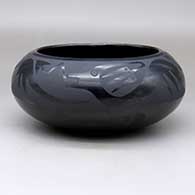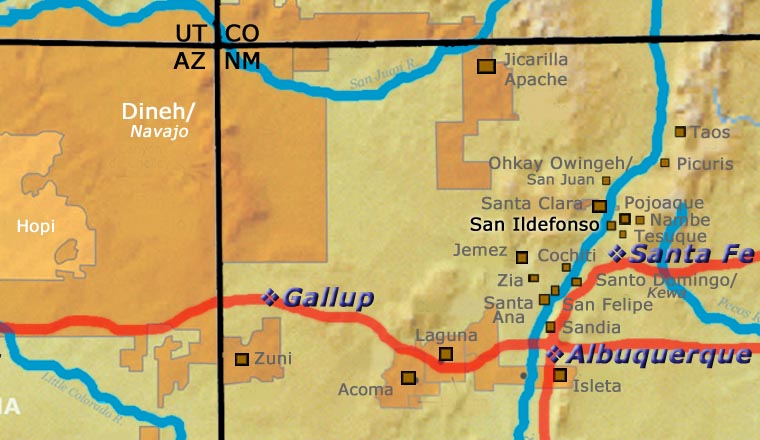
Santana Martinez
1909-2002
San Ildefonso

Santana Roybal was born into a family of well-known San Ildefonso potters and painters. She grew up learning to make pots from her grandmother, Dominguita Pino Martinez.
Santana married Adam Martinez (first-born son of Maria and Julian Martinez) in 1926 and they lived in his parents' home for the next 8 years. During that time Santana learned Maria's way of making pots and Julian's methods of painting them.
After Julian passed away in 1943, Adam and Santana dedicated themselves to helping Maria continue with her business. Adam took over his father's duties with gathering and processing clay and firing pots. Santana worked with Maria making pots and painting them. The signature on most of Maria's pottery made through those years (1943-1956) reads "Marie + Santana".
In 1956 Maria began working with her youngest son, Popovi Da. It took him a while to get his skills up to snuff but that same year, he replaced Santana as Maria's primary painter. Adam and Santana graduated to making pottery on their own. Their signature became "Santana + Adam".
They were participants every year at the Santa Fe Indian Market from 1970 to 1999, earning several First, Second and Third Place ribbons plus Best of Class and Best of Division. In 1981 they earned the "Maria Poveka Award for Best Traditional San Ildefonso Pottery."
Andrea held an Indian Market Reception in the gallery featuring Adam and Santana on August 16, 1996. It was an evening cherished by all who came.
Adam and Santana had seven children and they taught most of them how to make pottery the traditional way.
Some Exhibits that Featured Adam and Santana's Work:
- Awa Tsireh: Pueblo Painter and Metalsmith. Heard Museum. Phoenix, Arizona. November 4, 2017 - July 1, 2018. Note: curated by Diana F. Pardue and Norman Sandfield; accompanied by a catalog.
- A Century of Pueblo Painters: San Ildefonso Pueblo 1900-1999. Adobe Gallery. Santa Fe, New Mexico. March 3, 2017 - April 30, 2017. Group show and sale with the following artists: José Angela Aguilar, Gilbert Atencio, Popovi Da, Tony Da, Louis Gonzales, Julián Martinez, Richard Martinez, Santana Roybal Martinez, José Encarnacion Peña, Tonita Vigil Peña, Tony Pena, Alfonso Roybal, José Disiderio Roybal, Tonita Roybal, Abel Sanchez, Romando Vigil, and Tomacito Vigil
- Something Old, Something New, Nothing Borrowed: New Acquisitions from the Heard Museum Collection. Heard Museum. Phoenix, Arizona. April 2, 2011 - March 18, 2012
- Gifts from the Community. Heard Museum West. Surprise, AZ. April 12, 2008 - October 12, 2008
- Home: Native Peoples in the Southwest. Heard Museum. Phoenix, AZ. 2005
- The Collection Passions of Dennis and Janis Lyon. Heard Museum. Phoenix, AZ. May 1, 2004 - September 1, 2004
- A Revolution in the Making: The Pottery of Maria and Julian Martinez. Heard Museum. Phoenix, AZ. May 10, 2003 - September 14, 2003
- Hold Everything! Masterworks of Basketry and Pottery from the Heard Museum. Heard Museum. Phoenix, AZ. November 1, 2001 - March 10, 2002
- Passionate Involvement: Recent Acquisitions of the Heard Museum. Heard Museum. Phoenix, AZ. March 1, 2001 - October 1, 2001
- The Legacy of Generations: Pottery by American Indian Women. Heard Museum. Phoenix, AZ. February 14, 1998 - May 17, 1998
- The Legacy of Generations: Pottery by American Indian Women. The Museum of Women in the Arts. Washington, DC. October 9, 1997 - January 11, 1998
- Recent Acquisitions from the Herman and Claire Bloom Collection. Heard Museum. Phoenix, AZ January 11, 1997 - July 1,1997
- 1979 Heard Museum Guild Indian Arts & Crafts Exhibit. Heard Museum. Phoenix, Arizona. November 21, 1979 - December 3, 1979
- 1978 Heard Museum Guild Indian Arts & Crafts Exhibit. Heard Museum. Phoenix, Arizona. November 24, 1978 - December 2, 1978
- The Martinez Tradition. Heard Museum. Phoenix, Arizona. April 29, 1978 - August 30, 1978
- 1977 Heard Museum Guild Indian Arts & Crafts Exhibit. Heard Museum. Phoenix, Arizona. November 25, 1977 - December 3, 1977
- 1969 Heard Museum Guild Indian Arts and Crafts Show. Heard Museum. Phoenix, Arizona. 1969.
- 1968 Heard Museum Guild Indian Arts and Crafts Show. Heard Museum. Phoenix, Arizona. 1968.
Some Awards Earned by Adam and Santana:
- 1990 Santa Fe Indian Market, Classification II - Pottery, Division E - Traditional pottery, painted designs on burnished black or red surface, Category 1108 - Plates: Third Place
- 1986 Santa Fe Indian Market, Classification II - Pottery, Division E - Traditional pottery, painted designs on burnished black or red surface: Best of Division with Adam Martinez
- 1986 Santa Fe Indian Market, Classification II - Pottery, Division E - Traditional pottery, painted designs on burnished black or red surface, Category 1101 - Jars up to 8 inches tall: Second Place
- 1986 Santa Fe Indian Market, Classification II - Pottery, Division E - Traditional pottery, painted designs on burnished black or red surface, Category 1103 - Bowls: First Place
- 1984 Santa Fe Indian Market, Classification II - Pottery, Division E - Traditional pottery, painted designs on burnished black or red surface: Best of Division with Adam Martinez
- 1984 Santa Fe Indian Market, Classification II - Pottery, Division E - Traditional pottery, painted designs on burnished black or red surface: Category 1101 - Jars up to 8 inches tall: First Place. Awarded for collaborative artwork with Adam Martinez
- 1983 Santa Fe Indian Market, Classification II - Pottery, Division B - Traditional, undecorated: Third Place
- 1979 Heard Museum Guild Indian Arts & Crafts Exhibit, Classification VII - Pottery, Division A - Traditional methods of construction and firing: Honorable Mention. Awarded for artwork: Mat Design Bowl
- 1978 Heard Museum Guild Indian Arts & Crafts Exhibit, Classification VII - Pottery, Division A - Traditional: First Place shared with Adam Martinez. Awarded for artwork: Wedding jar
- 1978 Heard Museum Guild Indian Arts & Crafts Exhibit, Classification VII - Pottery, Division A - Traditional: Honorable Mention shared with Adam Martinez. Awarded for artwork: Small jar
- 1977 Heard Museum Guild Indian Arts & Crafts Exhibit, Classification VII - Pottery, Division A - Traditional shapes and design: Second Place with Adam Martinez. Awarded for artwork: Large bowl with lid
- 1969 Heard Museum Guild Indian Arts & Crafts Exhibit, Classification X - Pottery, Division A - Traditional as to materials, methods, shape, and design: Third Place
- 1968 Heard Museum Guild Indian Arts & Crafts Show, Classification IX - Pottery, Division A - Traditional materials, methods and design: First Place with Adam Martinez. Awarded for artwork: Feather Design Jug
- 1922 Southwest Indian Fair and Arts and Crafts Exhibition: Drawings of Pottery Designs: Pupils of Pueblo Day School: First Place. National Guard Armory, Santa Fe, New Mexico. September 1922. Note: awarded the Dougan Fund Prize for $2.00
100 West San Francisco Street, Santa Fe, New Mexico 87501
(505) 986-1234 - www.andreafisherpottery.com - All Rights Reserved

San Ildefonso Pueblo
San Ildefonso Pueblo is located about twenty miles northwest of Santa Fe, New Mexico, west of Pojoaque, south of Santa Clara and straddling the Rio Grande. Although their ancestry has been traced to prehistoric pueblos in the Greater Mesa Verde area, the prehistoric pueblo at Tsankawi, in a non-contiguous parcel of Bandelier National Monument, is their most recent ancestral home. Tsankawi abuts the reservation on its northwest side.
Franciscan monks named the village after San Ildefonso and in 1617, forced the tribe to build a mission church on top of the village's main kiva. Before that the village was known as Powhoge, "where the water cuts through" (in Tewa). Today's pueblo was established as long ago as the 1300s. When the Spanish arrived in 1540, they estimated the village population at about 2,000.
That mission was destroyed during the Pueblo Revolt of 1680 and when Don Diego de Vargas returned to reclaim San Ildefonso in 1694, he found virtually all the Tewa people camped out on top of nearby Black Mesa. After an extended siege the two sides negotiated a treaty and the people returned to their villages. However, the next 250 years were not so good for them.
The swine flu pandemic of 1918 reduced the pueblo's population to about 90. Their population has grown to more than 600 since but the only economic activity available on the pueblo itself involves creating art in one form or another. The only other work is off-pueblo. San Ildefonso's population is small compared to neighboring Santa Clara Pueblo, but the pueblo maintains its own religious traditions and ceremonial feast days.
San Ildefonso is most known for being the home of the most famous Pueblo Indian potter, Maria Martinez. Many other excellent potters from this pueblo have produced quality pottery, too, among them: Blue Corn, Tonita and Juan Roybal, Dora Tse Pe and Rose Gonzales. Of course, the descendants of Maria Martinez are still important pillars of San Ildefonso's pottery tradition. Maria's influence reached far and wide, so far and wide that even Juan Quezada of the Mata Ortiz pottery renaissance in Chihuahua, Mexico, came to San Ildefonso to learn from her.
100 West San Francisco Street, Santa Fe, New Mexico 87501
(505) 986-1234 - www.andreafisherpottery.com - All Rights Reserved


Santana Martinez, San_Ildefonso, Anopenblackonblackbowldecoratedabovetheshoulderwithanavanyuandgeometricdesign
San Ildefonso
$ 1500
cjsi4j136
An open black on black bowl decorated above the shoulder with an avanyu and geometric design
7.75 in L by 7.75 in W by 3.25 in H
Condition: Very good
Signature: Santana Adam
100 West San Francisco Street, Santa Fe, New Mexico 87501
(505) 986-1234 - www.andreafisherpottery.com - All Rights Reserved




